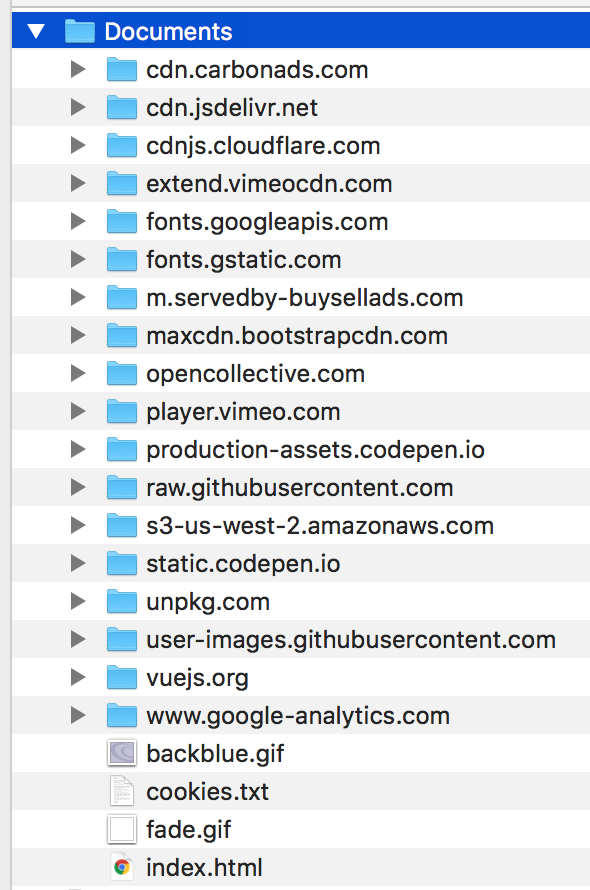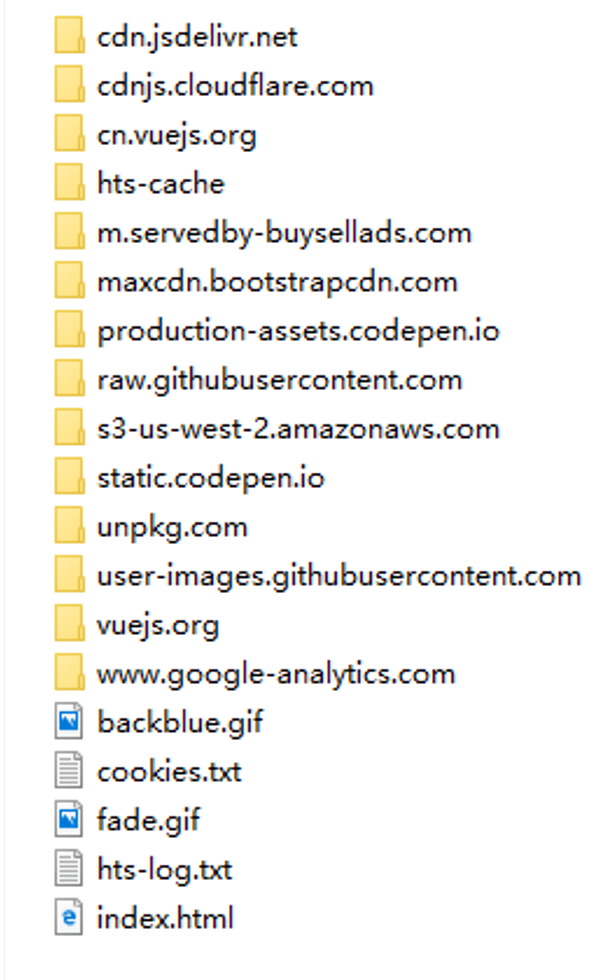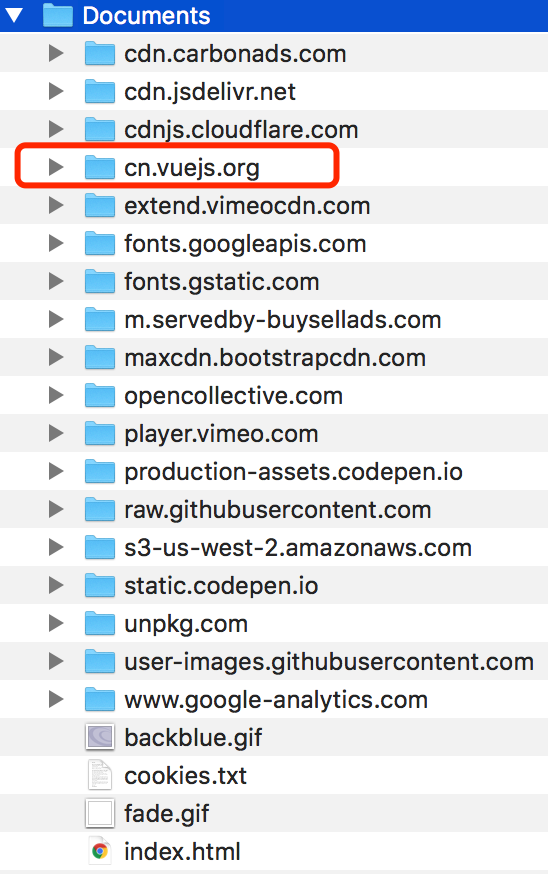- Vue.docset dash 文档 Vue文档中文版
- 取自官方 https://cn.vuejs.org (Version:2.6.11)
- 持续更新
- 提供制作过程
- Mac下用户下载 Dash 使用文档
- Windows 和 Linux 用户可下载 Zeal 使用本文档
Dash所需的文档都是.docSet后缀的文件,其实docSet文件就是一个文件夹而已,里头包含最终的html文档,以及根据html建立的索引(索引放在sqlite数据库中)。
生成文档的方法有很多种,如 Python、Ruby、Objective-C、Node.js、PHP
可以选择 镜像时处理,也可以镜像后处理。只需要结果中包含html,以及sqlite 就OJBK。
这里我选择 镜像后用NodeJS处理
需要用到的库为:
fs做一些文件的读写操作path路径处理sync-exec执行一些cmd命令sqlite-sync做一些 sqlite 操作cheerio服务器版的jQuery
根据官网提供的官方文档,整个转换主要有以下5个步骤:
1. 创建Docset目录结构(Create the Docset Folder);
2. 复制HTML文件(Copy the HTML Documentation);
3. 创建Info.plist文件(Create the Info.plist File);
4. 创建SQLite数据库文件(Create the SQLite Index);
5. 写入SQLite数据索引(Populate the SQLite Index);
镜像工具有很多,这里只推荐我尝试过的几款,并且用着还不错:
| 名称 | 平台 | 地址 |
|---|---|---|
| HTTrack | OS X / Windows/Linux/Unix/BSD | http://www.httrack.com |
| SiteSucker | OS X | http://sitesucker.us/home.html |
| Cyotek WebCopy | Windows | https://www.cyotek.com/cyotek-webcopy |
实际上这几种都不是很完美,或多或少会漏一些外部站点的资源文件,目前还没找到解决办法,
如果你们有解决办法,麻烦**@**我一下。
我这里以SiteSucker 为例,镜像 https://cn.vuejs.org ,一级目录结构如下:
// cn.vuejs.org
├── _00.txt
├── _downloads.html
├── coc
├── css
├── fonts
├── guide
├── images
├── index.html
├── js
├── manifest.json
├── support-vuejs
└── v2
重点关注对象为以下,提取其中的内容,生成索引
cn.vuejs.org/v2/api/index.html(API 列表)cn.vuejs.org/v2/guide/*(官网教程列表)cn.vuejs.org/v2/style-guide/index.html(风格指南)
参考Dash的Vue文档,一层层拨开后,发现官方用的HTTrack做的镜像,并且资源文件比我自己用HTTrack镜像下来的资源齐全,一番折腾下来,也没成功。
对比后选择用官方的外部资源,文档内容则用自己镜像的
- 左侧为dash官方文档中的资源 、中间为合并后的资源(后面要用到)、 右侧为自己镜像的资源
本例中我们创建的文档叫 VueJS,所以按下列结构创建目录:
mkdir -p VueJS.docset/Contents/Resources/Documents/
把所有的html文档拷贝到Documents文件夹中,dash默认 Documents 为文档根目录
为了省事,我把需要的资源文件放在了当前项目下。
cp -r ./Documents VueJS.docset/Contents/Resources/
在 VueJS.docset/Contents/ 中创建Info.plist文件,注意文件名的大小写,文件内容如下:
<?xml version="1.0" encoding="UTF-8"?>
<!DOCTYPE plist PUBLIC "-//Apple//DTD PLIST 1.0//EN" "http://www.apple.com/DTDs/PropertyList-1.0.dtd">
<plist version="1.0">
<dict>
<key>CFBundleIdentifier</key>
<string>VueJS</string>
<key>CFBundleName</key>
<string>VueJS-CN</string>
<key>DocSetPlatformFamily</key>
<string>VueJS</string>
<key>isDashDocset</key>
<true/>
<key>DashDocSetFamily</key>
<string>dashtoc3</string>
<key>dashIndexFilePath</key>
<string>cn.vuejs.org/index.html</string>
</dict>
</plist>
一个xml文件,里面都是成对的key-string配置项
dashIndexFilePath表示在Dash中点击你的文档后,默认的主页是什么CFBundleName为在dash 中的文档名称DashDocSetFamily左下角显示索引列表 (这里我有配置,但是没生效,后续再研究)- 其他部分为一些关键字
-
创建sqlite索引。
索引文件的位置是:VueJS.docset/Contents/Resources/docSet.dsidx ,(Mac电脑已经预装了sqlite)
所以直接从命令行进入Resources文件夹,在命令行中敲:
sqlite3 docSet.dsidx -
这样就进入了sqlite数据库,接下来,创建数据表
CREATE TABLE searchIndex(id INTEGER PRIMARY KEY, name TEXT, type TEXT, path TEXT)
再往后就是,从html文件中提取内容,插入索引。这是最重要的一点,这里没弄好,整个都没啥用。
INSERT OR IGNORE INTO searchIndex(name, type, path) VALUES ('name', 'type', 'path');
其中
name为关键字,比如你想在dash中输入一个select就可以查询,那这个select就是关键字;type为关键字的类型,官方支持的有很多,如Class、Function、Guide、Method等;path为文档的锚点地址,点击目录跳转
官方原文为:
nameis the name of the entry. For example, if you are adding a class, it would be the name of the class. This is the column that Dash searches.typeis the type of the entry. For example, if you are adding a class, it would be "Class". For a list of types that Dash recognises, see below.pathis the relative path towards the documentation file you want Dash to display for this entry. It can contain an anchor (#). Alternatively, Dash also supportshttp://URL entries.
以下为我的部分代码,完整的代码在 build-vue.js
// build-vue.js
/**
* 根据各个标题处理相应的锚点 添加索引
*
* @param $ dom 对象
* @param relativePath 相对路径
* @param dir 文件夹名称
*/
function handleTitles($,relativePath,dir) {
// 教程模块 以h2 为索引,需要添加一个h1 的索引
let h1Title = '';
if(dir === 'guide'){
$('h1').each(function (i,h) {
h1Title = Array.from(h.childNodes).map((node) => node.data ).join('');
db.run(`INSERT INTO searchIndex (name, type, path) VALUES ('${h1Title}', '${type['guide']}', '${relativePath}')`,function(res){
if(res.error) throw res.error;
console.log(res);
});
});
}
$('h2').each(function (i,h) {
if(!h.attribs.id) return;
let h2s = extractText(h); // 提取标题中的ID、文本内容
let h3s = [];
if(dir === 'api'){
h3s = collectH3s(h);
if(h3s.length<1) return
}
let entryType = type[h2s.id] || type['h2']; // 默认 Section
console.log(h2s);
let h2Num = dir === 'api' ? 1 : 0;
let h2Type = type['h2']; // h2 归类为 Section
addDashAnchor(h,h2s.id,h2Type,h2Num);
let inTitle = `${h2s.text} ${dir === 'guide' ? ' - '+ h1Title : ''}`;
let iniType = dir ==='api' ? type['guide'] : h2Type;
db.run(`INSERT INTO searchIndex (name, type, path) VALUES ('${inTitle}', '${iniType}', '${relativePath}#${encodeURIComponent(h2s.id)}')`,function(res){
if(res.error) throw res.error;
console.log(res);
});
// api下 需要处理 h3 标题,生成相应的索引
if(dir === 'api'){
h3s.forEach(function (titleNode,index) {
let id = titleNode.attribs.id;
let text = [].slice.call(titleNode.childNodes).map( (node) => node.data).join('');
// 需要处理括号
if(text.match(/^([^(]+)\(/)) text= text.match(/^([^(]+)\(/)[1];
console.log(id,text,entryType);
addDashAnchor(titleNode,id,entryType,0);
db.run(`INSERT INTO searchIndex (name, type, path) VALUES ('${text}', '${entryType}', '${relativePath}#${encodeURIComponent(id)}')`,function(res){
if(res.error) throw res.error;
console.log(res);
});
});
}
});
/**
* 提取标题中的ID、文本内容
* @param h node
* @returns {{id: *, text: *}} id 用来生成锚点、text当做标题
*/
function extractText (h) {
let title = [].slice.call(h.childNodes).map( (node) => node.tagName === 'a' ? node.attribs.title : '').join('');
let id = h.attribs.id;
return {
id: id,
text: title ? htmlEscape(title) : id // 如果没有就用ID 代替
}
}
// 字符转义
function htmlEscape (text) {
return text
.replace(/&/g, '&')
.replace(/"/g, '"')
.replace(/'/g, `'`)
.replace(/</g, '<')
.replace(/>/g, '>')
}
// 提取h2 附近的h3 标题列表
function collectH3s (h) {
let h3s = [];
let next = h.nextSibling;
while (next && next.tagName !== 'h2') {
if (next.tagName === 'h3') {
next.childNodes = removeTagA(next);
h3s.push(next)
}
next = next.nextSibling
}
return h3s
}
// 移除A标签
function removeTagA(h) {
return [].slice.call(h.childNodes).filter(function (node) {
return node.tagName !== 'a'
})
}
// 添加dash规定格式的 锚点
function addDashAnchor(h,name,types,num) {
let nameStr = (`//dash_ref_${name}/${types}/${encodeURIComponent(name)}/${num}`); // 需要对URL 进行URL编码(百分比转义)
let dashAnchor = `<a class="dashAnchor" name="${nameStr}"/>`;
h.childNodes = removeTagA(h); // 取完title之后移除原有的锚点,添加 dash规定格式的锚点
$(h).before(dashAnchor).html();
}
}
把所有的索引数据都插入到searchIndex以后,docSet文档就制作好了,直接双击 VueJS.docSet就可以导入Dash了。






